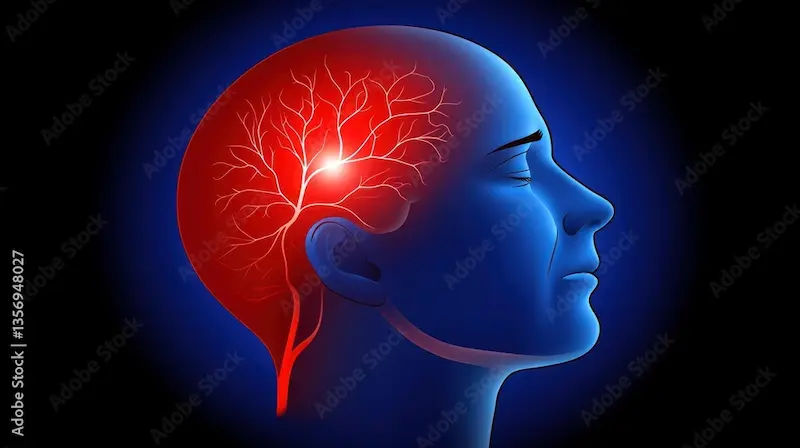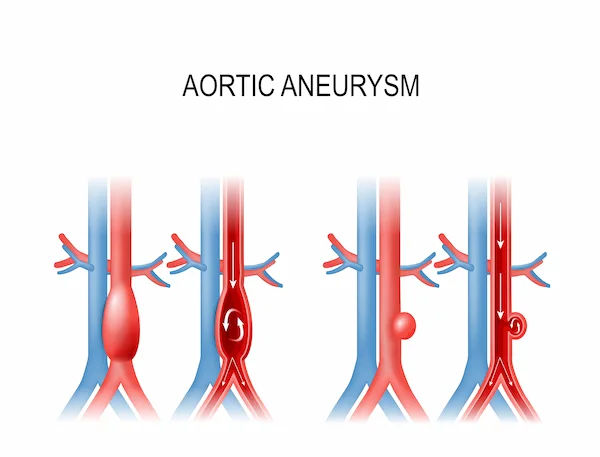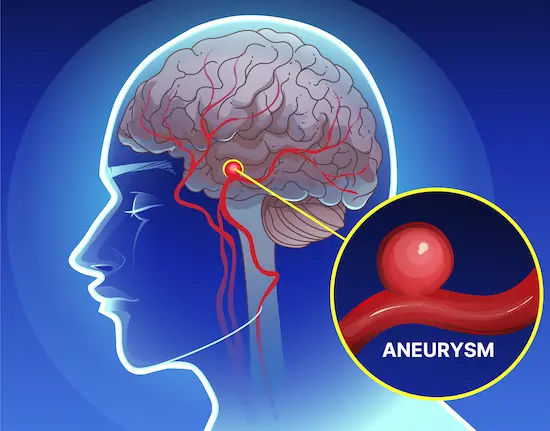What Leads To Signs Of Aneurysms And Types?
Learn about the common causes, risk factors, and symptoms that lead to different types of aneurysms. Understand the warning signs to help identify this potentially life-threatening condition early.

Written by Dr. M L Ezhilarasan
Reviewed by Dr. Dhankecha Mayank Dineshbhai MBBS
Last updated on 10th Sep, 2025

Aneurysm Causes, Warning Signs, and Main Types Explained
An aneurysm is a silent, often undetectable condition that can become a life-threatening medical emergency in an instant. Imagine a weak spot on a balloon; as you inflate it, that spot stretches and thins, becoming dangerously prone to popping. An aneurysm is similar but occurs in the wall of an artery. Many people live with an aneurysm for years, completely unaware, until it grows large enough to cause pressure or, in the worst case scenario, ruptures. Understanding what leads to these vascular weak spots, recognizing the potential signs—however subtle—and knowing the different types is the first critical step in proactive health management. This guide will demystify aneurysms, breaking down their causes, the warning symptoms you should never ignore, and the characteristics of the most common types.
What Exactly is an Aneurysm?
The Weak Spot in the Artery Wall
- An aneurysm is an abnormal bulge or ballooning in the wall of a blood vessel, almost always an artery. Arteries are the high-pressure pipelines that carry oxygen-rich blood from your heart to the rest of your body. Due to constant pressure, a weakened section of the arterial wall can begin to swell outwards. This bulge is the aneurysm. The main danger lies in its potential to expand further and eventually rupture, causing severe internal bleeding, which is often catastrophic and fatal. Aneurysms can develop in any artery, but the most common and dangerous sites are the aorta (the body's main artery) and the arteries in the brain.
The Root Causes: What Leads to an Aneurysm?
Aneurysms form due to a combination of factors that weaken the sturdy, elastic walls of your arteries. It’s rarely one single cause but rather a perfect storm of conditions.
Atherosclerosis: The Primary Culprit
- Atherosclerosis, or the hardening of the arteries due to plaque buildup (cholesterol, fat, and other substances), is a leading cause. This plaque damages the inner lining of the artery wall, reducing its elasticity and strength. Over time, the constant force of blood pressure pushing against this weakened area can cause it to bulge, forming an aneurysm.
High Blood Pressure: The Constant Pressure
- Hypertension (high blood pressure) is a massive contributing factor. Think of it like overinflating a tire. Chronically high pressure within your arteries places excessive stress on every part of the vessel wall, especially areas already weakened by conditions like atherosclerosis. This relentless force accelerates the stretching and bulging process.
Genetic and Connective Tissue Disorders
- Some people are born with a genetic predisposition or have conditions that affect their body's connective tissues, which provide strength and elasticity to artery walls. Disorders like Marfan syndrome, EhlersDanlos syndrome, and LoeysDietz syndrome can lead to inherent weakness in the aortic wall, making individuals much more susceptible to developing aneurysms, often at a younger age. A strong family history of aneurysms is a significant risk factor.
Trauma, Infection, and Other Causes
- Direct trauma from an accident or injury can damage an artery and lead to an aneurysm. In rare cases, a bacterial or fungal infection in the artery wall (a condition called mycotic aneurysm) can weaken it. Other factors include smoking (which directly damages blood vessels), age (arteries weaken over time), and gender (men are more likely to develop aortic aneurysms).
Consult a General Physician for the best advice
Decoding the Signs: Symptoms of an Unruptured vs. Ruptured Aneurysm
The Silence of an Unruptured Aneurysm
- Most aneurysms are asymptomatic until they become very large or rupture. This is why they are so dangerous. An unruptured aneurysm might be discovered incidentally during a scan for an unrelated issue. However, if it grows large enough, it can press on surrounding nerves or tissues, causing symptoms. For example, a large unruptured brain aneurysm might cause a localized headache, eye pain, vision changes, or numbness on one side of the face.
The Catastrophe of a Rupture: Recognizing the Signs
A ruptured aneurysm is a medical emergency. The signs are sudden and severe:
- For a ruptured brain aneurysm: This causes a subarachnoid hemorrhage. The classic symptom is a "thunderclap headache" – a sudden, excruciating headache unlike any ever experienced before. This is often accompanied by nausea, vomiting, stiff neck, sensitivity to light, blurred or double vision, seizure, loss of consciousness, and confusion.
- For a ruptured abdominal aortic aneurysm (AAA): This causes massive internal bleeding. Symptoms include sudden, intense, and persistent abdominal or back pain, dizziness, rapid heart rate, clammy skin, shock, and loss of consciousness. Pain can also radiate to the groin or legs.
If you or someone else experiences any of these sudden, severe symptoms, call for emergency medical help immediately.
A Guide to the Different Types of Aneurysms
1. Abdominal Aortic Aneurysm (AAA)
This is the most common type of aortic aneurysm, occurring in the part of the aorta that runs through the abdomen.
- Causes and Risk Factors for AAA: Primarily linked to atherosclerosis and smoking. Other risk factors include being male, over 65, white, having a family history, and having high blood pressure.
- Signs and Symptoms of an AAA: Usually asymptomatic. If symptoms do appear, they can include a deep, constant pain in the abdomen or on the side of the abdomen, a throbbing sensation near the navel, and back pain.
2. Cerebral (Brain) Aneurysm
Also known as an intracranial aneurysm, this occurs in an artery within the brain.
- Causes and Risk Factors for a Brain Aneurysm: Similar to other aneurysms: family history, smoking, high blood pressure, age, and certain genetic disorders. They are more common in women than men.
- Signs and Symptoms of a Brain Aneurysm: Unruptured: Often none. Large unruptured ones may cause pain above or behind the eye, a dilated pupil, vision changes, or numbness. Ruptured: Thunderclap headache, nausea, neck stiffness, confusion, and loss of consciousness.
3. Thoracic Aortic Aneurysm
- This type occurs in the part of the aorta that passes through the chest cavity. It is often linked to genetic connective tissue disorders like Marfan syndrome. Symptoms, if they occur, can include pain in the jaw, neck, chest, or upper back, coughing, hoarseness, and difficulty breathing.
4. Peripheral Aneurysms
- These occur in other arteries, such as behind the knee (popliteal artery aneurysm), in the groin (femoral artery aneurysm), or in the neck (carotid artery aneurysm). They are less likely to rupture but can cause blood clots, leading to pain in the legs or feet during activity or, if a clot breaks free, triggering a stroke.
How Are Aneurysms Diagnosed?
Since they are often silent, diagnosis frequently happens by chance during tests for other conditions, such as an ultrasound, CT scan, or MRI. For those at high risk (e.g., older male smokers with a family history), screening is recommended. A simple, noninvasive abdominal ultrasound can effectively screen for an AAA. If an aneurysm is suspected, more detailed imaging like a CT angiography (CTA) or MR angiography (MRA) will be used to determine its exact size, location, and shape. If you have risk factors, consulting a doctor to discuss screening options is a crucial preventive step. Apollo24|7 offers convenient access to specialists who can evaluate your risk and recommend appropriate diagnostic steps.
Key Takeaways and Prevention Strategies
- Aneurysms are dangerous bulges in artery walls that can rupture, causing life-threatening bleeding.
- The biggest risk factors are atherosclerosis, high blood pressure, smoking, age, and family history.
- Most show no signs (asymptomatic) until they leak or rupture.
- A sudden, severe "thunderclap" headache or acute abdominal/back pain are red flags for a rupture—seek emergency help immediately.
- Screening via ultrasound is vital for high risk individuals, especially for Abdominal Aortic Aneurysms.
- You can reduce your risk by not smoking, managing blood pressure, eating a heart healthy diet, and exercising regularly.
If you have a family history or other concerns, consult a doctor online with Apollo24|7 for a personalized risk assessment.
Conclusion
Aneurysms are a formidable health challenge precisely because of their silent nature. The key to mitigating their threat lies in awareness and prevention. Understanding the underlying causes—such as uncontrolled high blood pressure, smoking, and genetics—empowers you to take control of modifiable risk factors. Recognizing the dire warning signs of a rupture can save a life by prompting immediate emergency action. While the thought of an aneurysm can be frightening, modern medicine offers effective screening, monitoring, and treatment options for those at risk. Proactive health management is your best defense. Don't wait for a symptom to appear; if you have concerns based on your family history or lifestyle, take the initiative to speak with a healthcare professional today.
Consult a General Physician
Consult a General Physician

Dr. Anand Ravi
General Physician
2 Years • MBBS
Bengaluru
PRESTIGE SHANTHINIKETAN - SOCIETY CLINIC, Bengaluru

Dr. Vivek D
General Physician
4 Years • MBBS
Bengaluru
PRESTIGE SHANTHINIKETAN - SOCIETY CLINIC, Bengaluru

Dr Syed Mateen Pasha
General Physician
2 Years • MBBS
Bengaluru
PRESTIGE SHANTHINIKETAN - SOCIETY CLINIC, Bengaluru

Dr. Harshendra Jaiswal
General Physician/ Internal Medicine Specialist
12 Years • MBBS , MD (General medicine)
Kolkata
108 DHANA DHANVANTARI Clinic, Kolkata
(25+ Patients)

Dr. Syed Ismail Ali
General Practitioner
7 Years • MBBS
Hyderabad
Apollo 24|7 Clinic, Hyderabad
Consult a General Physician for the best advice

Dr. Anand Ravi
General Physician
2 Years • MBBS
Bengaluru
PRESTIGE SHANTHINIKETAN - SOCIETY CLINIC, Bengaluru

Dr. Vivek D
General Physician
4 Years • MBBS
Bengaluru
PRESTIGE SHANTHINIKETAN - SOCIETY CLINIC, Bengaluru

Dr Syed Mateen Pasha
General Physician
2 Years • MBBS
Bengaluru
PRESTIGE SHANTHINIKETAN - SOCIETY CLINIC, Bengaluru

Dr. Harshendra Jaiswal
General Physician/ Internal Medicine Specialist
12 Years • MBBS , MD (General medicine)
Kolkata
108 DHANA DHANVANTARI Clinic, Kolkata
(25+ Patients)

Dr. Syed Ismail Ali
General Practitioner
7 Years • MBBS
Hyderabad
Apollo 24|7 Clinic, Hyderabad
More articles from Aneurysm
Frequently Asked Questions
Can you feel an aneurysm before it ruptures?
Most often, no. Unruptured aneurysms are typically silent. However, a large aneurysm pressing on nerves or tissues can cause symptoms like localized pain, vision problems, or a pulsating feeling in the abdomen, depending on its location.
What is the typical abdominal aortic aneurysm pain location?
Pain from a growing or leaking AAA is typically felt in the abdomen, the lower back, or the sides of the abdomen. It is often described as deep, constant, and gnawing. Pain from a rupture is sudden, severe, and can radiate to the back or groin.
Are there any warning signs of a brain aneurysm days before?
A sudden rupture usually occurs without specific warning days prior. However, in some cases, a small leak from the aneurysm (a 'sentinel bleed') may cause a sudden, unusually severe headache hours or weeks before a major rupture. This is a critical warning sign that requires immediate medical attention.
Can stress cause an aneurysm to rupture?
While stress itself doesn't cause an aneurysm to form, a sudden spike in blood pressure from intense emotional stress or physical exertion can potentially trigger the rupture of an existing, weakened aneurysm.
How are aneurysms treated?
Treatment depends on size, location, and growth rate. Small, stable aneurysms may be monitored regularly with imaging. Larger or growing aneurysms may require surgery, such as open surgical repair or a less invasive procedure called endovascular stent grafting.




